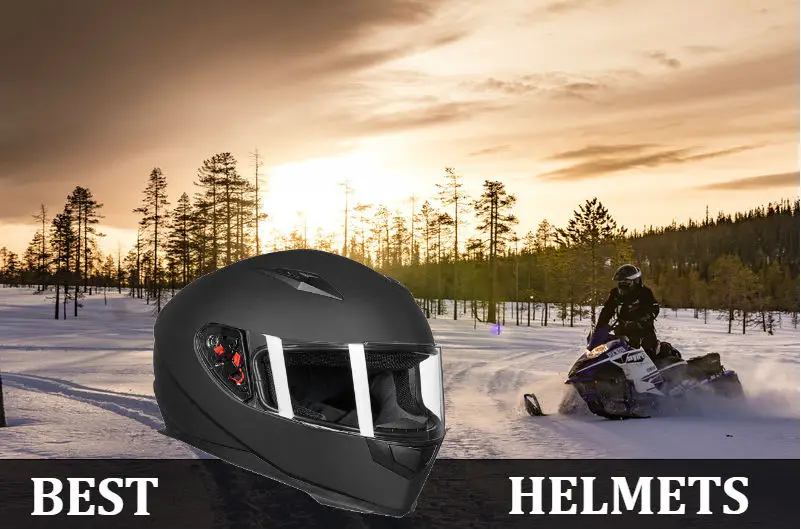Choosing your helmet is one of the most important safety decision you will make before riding a sled. Now that we are through with the basics and with what we need to do in case you get your sled sunk in water or mud, it is time to move onto the next step: Choosing your gear. And today, I will be talking about choosing the right snowmobile helmet.
Snowmobile helmets or ”shells” are, like with any other motorsport, the most crucial piece of gear that you can own as a rider. Not only do they keep your face warm, fuzzy and protected from the cutting winter wind, but they also protect your head from silly stuff such as, and not limited to: frontal and rear collisions with trees, branches, rocks, animals, people, small birds, snow, babies and trail debris.
Over the years, snowmobile helmets have been adapted and improved so much so that they are, by today’s standards, more than capable of protecting not only your skull but your dreams also from shattering into a multitude of small fragments. And said standards are improving with each passing year, both in the field of design efficiency and in the quality of materials used in their creation.
However, before purchasing a helmet, you must make sure that it will match your riding style, your personal preferences and the safety standards that you are looking for.
Types of helmets
There are multiple types of snowmobile helmets. Over the years, snowmobile helmets have been constantly redesigned in order to facilitate all the different styles of riding the snowmobile. Each of them presents their own unique advantages and disadvantages, ranging from prices to minor quirks and specific impacts upon your sledding experience.
And regardless of their type, size, color, and producer, there are a few key aspects that are universal when buying a helmet:
- Make sure your head is comfortably snug when putting it on;
- To properly check this, keep your head stiff and facing forward and with your hands grab them by their front end and try to move them from side to side, then up and down. A properly sized shell will not move more than an inch.
- Make sure the safety strap is securely fastened;
- Make sure it is the lightest helmet you can get your hands on, but without skimping on the quality factor. There are three general sizes of shells:
- Youth shells: mainly for young people or people with really small heads (I don’t judge), they are the lightest of the three. Make sure that if you buy it for someone, they stay with it as long as possible. Only when it starts to not fit them anymore should you upgrade to something heavier.
- Adult-smaller shells: those are the most used on in the sport, due to the simple fact that this type of helmets fits the greatest range of head sizes; this means that they range from small adult sizes to large adult sizes.
- Adult-large shells: those behemoths go from extra-large to larger than that. Wear them only if they fit you properly.
- Make sure the helmet is safety approved – turn it around and check its backside for any label that proves it passed inspection;
Snowmobile Helmets Safety Ratings
Safety ratings are usually either ”DOT” or ”SNELL” rated. While both their intended goal is to protect you, the difference between the two is that they serve entirely opposite purposes:
- Many people make the mistake of thinking that the ”SNELL” rated helmets are the better ones. It is not true. ”SNELL” rated helmets are meant to protect you from higher speed collisions. This means that they are ideal if your style of sledding revolves around riding open plains at 60+ miles an hour. Their job is to keep you alive in a high-speed impact.
- On the contrary, the ”DOT” rated helmets are best used while on rockier, mountainous terrain or when riding a snowmobile, A.T.V. or dirt bike at speeds lower than 60 miles an hour. This is due to their softer foam inside, which eases the shock of the impact. Their job is to lower the shock and the trauma of the collision as much as possible.
- A final rating would be ”ECE”, meaning The Economic Commission for Europe. This is exclusive only for products made and sold within the European Union and it means that the product has passed all quality and safety standards.
- Helmets become brittle over time, so make sure you replace them every 5 years or so;
- If you are involved in a crash, make sure to send it for inspection if possible or replace it altogether if it has any signs of cracks. Those things are sturdy, but not invincible.
The four main types of helmets are as follows:
- Full face
- Modular
- Snowcross
- Dual sport style
The ”full face” mask
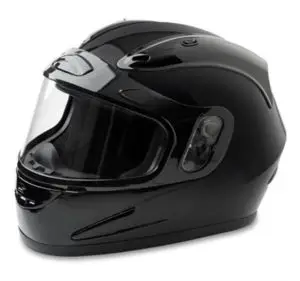
Full-Face snowmobile helmet
Also known as the ”vanilla mask”, it is the most commonly used type of helmet and for good reasons.
Due to its enclosed and all around well-designed shape, this one offers the greatest protection and level of comfort you could ask for.
The smooth curves make it surprisingly aerodynamic, which will make for a better and smoother riding experience.
This, combined with the sturdiness of the materials used, such as durable Polycarbonate, reinforced fiber, ABS thermal plastic composite shells and many others, will make sure that in case of an impact, your head won’t be cracking like ”a cold one with the boys”.
Again, I will mention polycarbonate. Due to its intended purposes, the full helm is often made from this very light, but durable synthetic material. This leads to the helmet being very lightweight, despite its large and cumbersome aspect.
Furthermore, there are very few moving components on it, so this will further add to its aerodynamic properties. Plus, fewer components means that there are fewer chances of it breaking when impacting something hard.
Furthermore, its closed design and large shield (also made of very tough materials) provide you with maximum protection from debris, snow, and wind, similar to motorcycle helmets.
Its major disadvantage, however, is its lack of protection offered against strong lights (sun rays or light reflecting from the snow). Communication is also a bit hindered, but it is nothing you cannot solve with simply raising the shield or taking it off. Though, be careful not to do it during the ride.
Another trait which puts it at a disadvantage against the other helmets with a retractable shield/goggles is that in the case of an emergency (let’s say broken neck), medical crews will have a harder time accessing your face without removing the helm.
With it’s few disadvantages aside, this is why despite its bulky and enclosed design, the full helm has been and still is the preferred choice of most riders, new and old.
To sum it all up:
Simplicity and efficiency made manifest.
The ”modular” shell
Modular helmets are a hybrid of full-faced and open-faced helmets, designed specifically for added comfort. This is due to their ability to open into an open faced helmet.
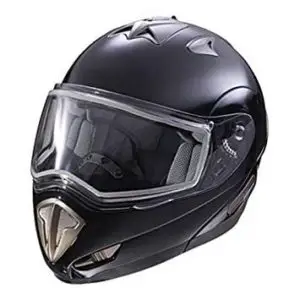
Modular Shell snowmobile helmet
This type of helmet serves more purposes other than making you look like the protagonist of the Crysis game series.
In all actuality, it is very similar to the full face helmet, both being considered full faced helmets, although with a few specific quirks of its own.
First of all, it looks awesome. It goes further than the vanilla design and brings something new to the table for those who buy it. Its design is made so that it pays with some (although minuscule) percentage of its protection factor for more incorporated mobility.
Unlike the previous one, where the faceplate is part of the ”boney” structure of the helmet and the shield is the only movable component, thus adding more protection during accidents, this one’s faceplate is movable, allowing the wearer to easily communicate and to get a fresh wiz of air in between rides, without having to remove the helmet entirely. If the former helmet is a motorcyclist’s helmet, think of this one as a welder’s faceplate.
Furthermore, many of them come with a ”Dual visor” system, where one visor protects your face from the outside, while the other acts in the same manner as sunglasses, all accessible with a simple lever operation.
Another quirk is that many come with an incorporated ventilation shaft on the front of the mouthpiece. This is a very important thing to consider, seeing as how the rider will undoubtedly accumulate sweat and heat underneath, leading to condensation and the obstruction of the rider’s vision.
To sum it all up:
Sturdiness and elegance, all combined into one glorious piece of gear.
The ”snowcross” helmet
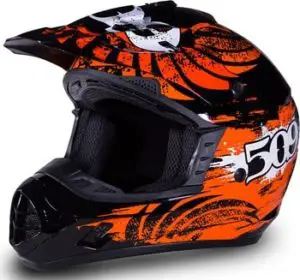
Snowcross snowmobile helmet
If motocross would have a twin, cooler brother, this would be it.
Not too different from its summer-time sibling sport, snowcross revolves less around riding around in frigid temperatures and more around riding the toughest terrain accessible with your self.
Its first and foremost advantage is that it has a rigid mouthpiece, meaning that, like the full-faced helmets, they provide a great deal of protection in case of an accident.
Same as with the motocross helmet, rather than having a shield to protect your face, with this you can use a pair of special snow goggles (the skying variant) in order to best protect you from the elements (both debris and the light).
Another added benefit is that due to the goggles, the wearer’s field of vision is greatly enhanced.
The difference between the two, however, is that the snowcross variant is made specifically for winter, so your face won’t freeze up. You can also add a breath guard to further protect your face from the cold.
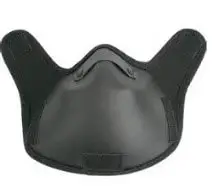
Furthermore, most snowcross riders acclaim this helmet for being as light, if not lighter than the full face variant and with better overall ventilation.
Besides, out of all of the helmets, those are acclaimed by most people for being the ”pimpiest” around.
To sum it all up:
Style and brute force combined.
The ”dual sport” helmet
Sharing many similarities with the snowcross helmet, the difference between the two is that while the snowcross one allows you to wear goggles, this version combines the designs of the full face helmet and the snowcross one.
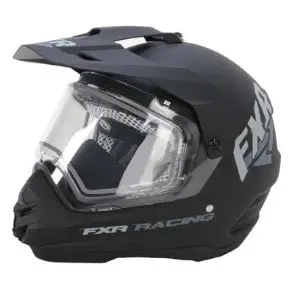
Dual sport snowmobile helmet
The design combines the structural integrity and the shield of the ”full face” for those who would rather have a shield rather than goggles, with the aesthetics of the snowcross helmet.
Despite the shield, however, it allows for a great deal of vision for the rider and an added bonus, it provides decent ventilation. The shield, while not as efficient as the goggles, is easier to use and even easier to maintain.
To sum it all up:
Elegance and practicality.
Half helmets
You will be as well protected by those things the way you would be without a helmet altogether. Their cheap price leads to a few considerable drawbacks:
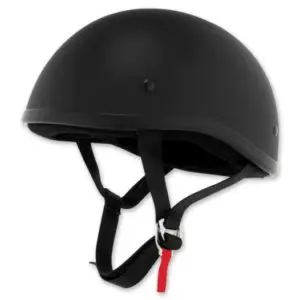
Helf helmet
- Only the top of the head is covered, allowing everything else to be exposed to danger;
- The quality of the used materials might be lackluster;
- They do not provide chin protection;
- The lack of an incorporated shield tempts the rider to skip the proper snowmobile goggles in favor of sunglasses. Avoid that at any costs. Sunglasses might protect your eyes from the light outside, but even their coverage is limited and the edges of your eyes will be exposed. And they will break like a kit-kat bar on impact, with the added consequences of your eyes being near them.
Best used in sports such as rock climbing and cycling, not sledding.
The three quarter helmet
Not too different from its half helmet sister, its only added benefit is that it also protects your cheeks and the lower portion of your head, right up until the lower half of your neck.
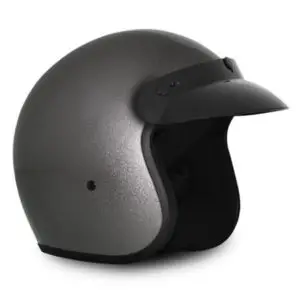
Three quarter snowmobile helmet
Other than that, it shares the same drawbacks with the half helmet, chief of them being that neither of them offers chin protection.
In case of a plunge, where you would fly face first into the ground, the lack of a chin or face protection could prove disastrous or even fatal, depending on the speed and collision surface.
Best used on scooters and in skydiving.
To sum up the half helmets and the three-quarter helmets:
Avoid them like the plague.
Auxiliary support systems/upgrades
A helmet is as good as the manufacturer makes it out to be. But this shouldn’t stop you from investing in additional quirks that will not only ease your experience but which will also improve it.
Upgrade your shield to a dual pane one: Those are the most common type of lens used by riders around the world. As its name implies, there are two lenses instead of one. While it might sound silly, two is better than one and in this case, this is a cheap yet sizable upgrade.
By design, the two lenses are separated by a thin layer of air that acts as insulation, thus preventing condensation from happening.
Get yourself a heated shield: Under normal circumstances, the dual pane shield will work fine in keeping the lens from fogging. However, when the temperatures drop low enough or it starts sleeting, the only way to totally prevent fogging is by using a heated shield.
The electrically heated variant presents a heating element that runs around the perimeter of the shield and plugs into the sleds’ electrical system.
Breath box/deflector: Contains and directs air exhaled through your nose and mouth downwards, away from your visor.
Chin curtain: Prevents air from entering from underneath your helmet.
Air vents: Multiple vents in the front and the back that open and close in order to allow air circulation to help regulate internal temperature and to prevent fogging.
Sun shield: Flips down inside the regular visor to protect your eyes from sun rays and snow reflection.
2-way radio: Allows you to keep a constant connection with someone else. The motorcycle variant will work as well as the snowmobile one does. The disadvantage is that it only allows two people to communicate at a time.
Helmet mounted camera: The GoPro cameras are the best since they are manufactured to resist cold weather and water and their quality is astounding. Such cameras will usually come with the means necessary to mount them to the helmet.
In order to mount them to any helmet, go get yourself a GoPro camera mount for about 20-30$. They can be attached to any type of helmet, at any angle and are made so that they can endure water and extreme cold. Those things are made to last and will never let you down.
Q&A
What is the lightest snowmobile helmet out there?
The full faced and the snowcross helms are considered to be the lightest.
What to choose: the 2-way radio or wireless/Bluetooth speakers?
Two-way radios are best if there is no signal around, if there are only two people and if there is some distance between speakers. It is lacking in sound quality, but it makes up with easy maintenance and ease of communication.
Get yourself Bluetooth if:
- You want good sound quality
- There are more than two people
- You want an easy to use interface
- You have money to spare
The range of the Bluetooth can go from 30 meters to 350 meters, depending on the price tag and the quality of the product. The battery life will usually last between 5 to 8 hours.
Is there a difference between female and male helmets?
No. Just make sure they fit properly.
Conclusion
Your choice of helmet comes really comes down to how often you ride, the conditions you ride in and your style of sledding.
If your passion is cross country riding, high-speed sledding or riding in sub-zero temperatures, full-faced helmets with added electric shields are the way to go.
If your passion is racing, extreme riding or off trail sledding, modular, snowcross or dual sports helmets should be your headgear of choice.
Regardless of your desired path, make sure to buy a good helmet. Once again, life beats money.
